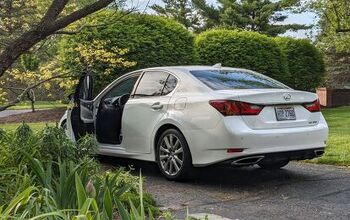Ford Seeks 'Mustang Mach-E' Trademark

While much of the hype surrounding Ford’s electrified future involves the brand’s upcoming “Mustang inspired” crossover EV, due in 2020, there are other models that stand to gain an (albeit milder) electric boost. The F-150 and Mustang, to name a couple.
Ford’s long-running pony car is expected to gain a hybrid variant sometime in 2020, and a new trademark filing sheds light on what name we might expect to see adorning the Stang’s flanks.
According to allfordmustangs.com, Ford recently filed a trademark application for the “ Mustang Mach-E” name with the European Intellectual Property Office. This piggybacks on last year’s European and American filings for the “Mach-E” name.
While the blue oval brand has been loathe to share many details on the hybrid Mustang, a patent uncovered earlier this year point to the possibility of a hybridized V8 pony car that catapults power and fuel economy over the existing Mustang GT. Then again, maybe a smaller Ecoboost motor would suffice. Who knows?
One thing’s for sure: Ford probably isn’t trademarking a Mustang Mach-E nameplate (and corresponding badge) to leave it sitting around. Given the time gap in “Mach-E” and “Mustang Mach-E” trademarks, it’s looking like Ford plans to go the Audi route with its electrified vehicle naming strategy. If it’s true that the Mustang-inspired electric crossover will carry the Mach-E name, then the moniker’s use on the Mustang points to it becoming a sub-brand, much like Audi’s e-tron and Mercedes-Benz’s EQ.
The Mustang’s future at Flat Rock Assembly is hazy, but a source with knowledge of Ford’s product plans tells us the model will soldier on with its current platform when a revamped Stang appears for the 2023 model year. Past rumors claimed that Ford might switch the model to its modular CD6 platform, but that doesn’t seem to be the case.
As for the expected hybrid version, there’s no word from our source on when that model will arrive. All Ford has said is that the model will appear in 2020, presumably for the 2021 model year.
[Image: Ford]

More by Steph Willems
Latest Car Reviews
Read moreLatest Product Reviews
Read moreRecent Comments
- Tassos Obsolete relic is NOT a used car.It might have attracted some buyers in ITS DAY, 1985, 40 years ago, but NOT today, unless you are a damned fool.
- Stan Reither Jr. Part throttle efficiency was mentioned earlier in a postThis type of reciprocating engine opens the door to achieve(slightly) variable stroke which would provide variable mechanical compression ratio adjustments for high vacuum (light load) or boost(power) conditions IMO
- Joe65688619 Keep in mind some of these suppliers are not just supplying parts, but assembled components (easy example is transmissions). But there are far more, and the more they are electronically connected and integrated with rest of the platform the more complex to design, engineer, and manufacture. Most contract manufacturers don't make a lot of money in the design and engineering space because their customers to that. Commodity components can be sourced anywhere, but there are only a handful of contract manufacturers (usually diversified companies that build all kinds of stuff for other brands) can engineer and build the more complex components, especially with electronics. Every single new car I've purchased in the last few years has had some sort of electronic component issue: Infinti (battery drain caused by software bug and poorly grounded wires), Acura (radio hiss, pops, burps, dash and infotainment screens occasionally throw errors and the ignition must be killed to reboot them, voice nav, whether using the car's system or CarPlay can't seem to make up its mind as to which speakers to use and how loud, even using the same app on the same trip - I almost jumped in my seat once), GMC drivetrain EMF causing a whine in the speakers that even when "off" that phased with engine RPM), Nissan (didn't have issues until 120K miles, but occassionally blew fuses for interior components - likely not a manufacturing defect other than a short developed somewhere, but on a high-mileage car that was mechanically sound was too expensive to fix (a lot of trial and error and tracing connections = labor costs). What I suspect will happen is that only the largest commodity suppliers that can really leverage their supply chain will remain, and for the more complex components (think bumper assemblies or the electronics for them supporting all kinds of sensors) will likley consolidate to a handful of manufacturers who may eventually specialize in what they produce. This is part of the reason why seemingly minor crashes cost so much - an auto brand does nst have the parts on hand to replace an integrated sensor , nor the expertice as they never built them, but bought them). And their suppliers, in attempt to cut costs, build them in way that is cheap to manufacture (not necessarily poorly bulit) but difficult to replace without swapping entire assemblies or units).I've love to see an article on repair costs and how those are impacting insurance rates. You almost need gap insurance now because of how quickly cars depreciate yet remain expensive to fix (orders more to originally build, in some cases). No way I would buy a CyberTruck - don't want one, but if I did, this would stop me. And it's not just EVs.
- Joe65688619 I agree there should be more sedans, but recognize the trend. There's still a market for performance oriented-drivers. IMHO a low budget sedan will always be outsold by a low budget SUV. But a sports sedan, or a well executed mid-level sedan (the Accord and Camry) work. Smaller market for large sedans except I think for an older population. What I'm hoping to see is some consolidation across brands - the TLX for example is not selling well, but if it was offered only in the up-level configurations it would not be competing with it's Honda sibling. I know that makes the market smaller and niche, but that was the original purpose of the "luxury" brands - badge-engineering an existing platform at a relatively lower cost than a different car and sell it with a higher margin for buyers willing and able to pay for them. Also creates some "brand cachet." But smart buyers know that simple badging and slightly better interiors are usually not worth the cost. Put the innovative tech in the higher-end brands first, differentiate they drivetrain so it's "better" (the RDX sells well for Acura, same motor and tranmission, added turbo which makes a notable difference compared to the CRV). The sedan in many Western European countries is the "family car" as opposed to micro and compact crossovers (which still sell big, but can usually seat no more than a compact sedan).
- Jonathan IMO the hatchback sedans like the Audi A5 Sportback, the Kia Stinger, and the already gone Buick Sportback are the answer to SUVs. The A5 and the AWD version of the Stinger being the better overall option IMO. I drive the A5, and love the depth and size of the trunk space as well as the low lift over. I've yet to find anything I need to carry that I can't, although I admit I don't carry things like drywall, building materials, etc. However, add in the fun to drive handling characteristics, there's almost no SUV that compares.


































Comments
Join the conversation
Does this mean the Lincoln version will be the Mach-E Mark?
Another commenter's post yesterday regarding the "Avellian" trim version of the Mach-E, and my response, seem to have gone missing.